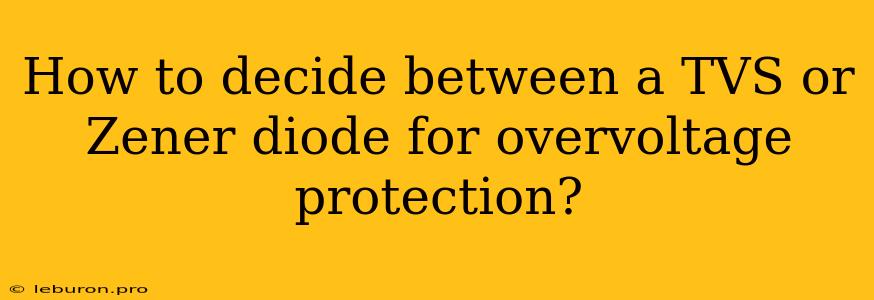Choosing the right component for overvoltage protection is crucial in electronic circuits, as it safeguards against potentially damaging voltage surges. Two commonly employed devices for this purpose are the TVS diode (Transient Voltage Suppressor) and the Zener diode. While both serve to protect circuits from excessive voltage, they differ significantly in their characteristics, making one more suitable for specific applications than the other. This article delves into the key differences between TVS diodes and Zener diodes in overvoltage protection, providing a comprehensive guide to help you make an informed decision for your circuits.
Understanding the Basics of TVS Diodes and Zener Diodes
Before diving into their differences, let's define each component.
TVS Diode: A Dedicated Overvoltage Protector
A TVS diode is designed specifically to handle transient voltage surges. It operates as a bidirectional device, clamping the voltage across it when the voltage exceeds its specified breakdown voltage. Unlike Zener diodes, TVS diodes can handle much higher energy surges and are primarily used in applications where high-energy transients are expected, such as power supplies, lightning protection, and electrostatic discharge (ESD) protection.
Zener Diode: A Voltage Regulator with Overvoltage Protection Capability
A Zener diode is primarily a voltage regulator, allowing current to flow in the reverse direction when the voltage across it exceeds its breakdown voltage, known as the Zener voltage. It is commonly used to regulate voltage levels in circuits and, as a secondary function, can offer basic overvoltage protection. However, Zener diodes have limitations in terms of energy handling capabilities and are better suited for low-power applications with infrequent overvoltage events.
Key Differences Between TVS and Zener Diodes for Overvoltage Protection
Here is a comprehensive breakdown of the critical differences between TVS diodes and Zener diodes in the context of overvoltage protection:
1. Energy Handling Capacity
TVS diodes excel in handling high-energy transients, making them suitable for situations where the overvoltage event is intense and potentially destructive. They have significantly higher power ratings compared to Zener diodes, which are more limited in their ability to absorb energy. This difference is rooted in the device's internal design and the materials used. TVS diodes typically employ a specialized structure to dissipate the energy, whereas Zener diodes are simpler in design and often struggle with high-power transients.
2. Response Time
Both TVS diodes and Zener diodes offer fast response times, essential for protecting circuits from damaging voltage spikes. However, TVS diodes generally have a slightly faster response time, especially when dealing with very fast transients. The quicker response time is due to the design of the TVS diode, which allows it to react more rapidly to sudden voltage fluctuations.
3. Clamping Voltage
The clamping voltage, the voltage at which the TVS diode or Zener diode starts conducting, is a critical parameter in overvoltage protection. TVS diodes typically offer a tighter clamping voltage range, ensuring the protected circuit remains within a safe operating voltage window. In contrast, Zener diodes may exhibit a wider clamping range, leading to a greater potential for voltage fluctuations and damage to the circuit.
4. Leakage Current
Zener diodes are known to have higher leakage current than TVS diodes when not conducting. This leakage current can be problematic in low-power circuits as it contributes to power dissipation and can affect circuit performance. TVS diodes have significantly lower leakage currents, making them a preferable choice for circuits with stringent power requirements.
5. Applications
The choice between TVS diodes and Zener diodes for overvoltage protection hinges on the specific application and the nature of the voltage transients. TVS diodes are ideal for applications where:
- High-energy transients are expected, such as power supplies, lightning protection, and ESD protection.
- Tight clamping voltage is required to minimize voltage fluctuations.
- Low leakage current is crucial for power-sensitive circuits.
Zener diodes are better suited for:
- Low-power circuits with infrequent overvoltage events.
- Voltage regulation as a primary function, with overvoltage protection as a secondary feature.
Choosing the Right Diode: A Decision Framework
To make the best choice for your overvoltage protection needs, consider the following steps:
- Identify the potential overvoltage sources: Determine the type and frequency of voltage transients your circuit might encounter.
- Define the energy level of the transients: Estimate the magnitude and duration of the voltage spikes you need to protect against.
- Specify the acceptable clamping voltage: Define the maximum voltage that your circuit can handle without damage.
- Assess the power dissipation requirements: Consider the amount of power that needs to be dissipated during overvoltage events.
- Evaluate the leakage current impact: Determine if leakage current from the chosen device will significantly affect circuit performance.
Based on your assessment, you can choose between TVS diodes and Zener diodes. If you need high energy handling capacity, tight clamping voltage, low leakage current, and fast response time, a TVS diode is the ideal choice. If you require simple voltage regulation with basic overvoltage protection, a Zener diode may be sufficient.
Conclusion
Ultimately, the decision of how to decide between a TVS or Zener diode for overvoltage protection depends on a careful analysis of the specific application requirements. By understanding the key differences between these two components, you can select the optimal protection solution to safeguard your circuits from damaging voltage surges. Both TVS diodes and Zener diodes play a crucial role in protecting electronic circuits from excessive voltage, but choosing the right device based on your needs ensures the most effective and reliable protection. Remember, the right choice can prevent costly repairs or equipment failures and enhance the overall reliability of your electronic systems.
